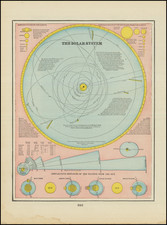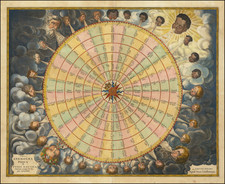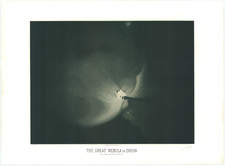Very nice example of this striking chart of the Northern Sky, illustrating the constellations of the Northern Hemisphere superimposed over the earth's Southern Hemisphere, from Andreas Cellarius's Harmonia Macrocosmica, first published in 1660.
The map provides a fantastic image of the stars, as if seen from deeper in space, so that each of the constellations is facing in the opposite direction from the way that the same constellations would be seen from earth.
This is the first of three plates (plate 24) to focus on northern hemisphere stars printed in Cellarius's work. This plate shows the stars as seen from the earth, in contrast to the other three which show the stars as seen from outside the supposed celestial sphere.
Cellarius's Harmonia Macrocosmica
The most sought after of all celestial atlases, this is the only one to be produced during the Dutch cartographic golden age. This work, Cellarius's magnum opus, was produced as a means to illustrate competing theories of celestial mechanics, during an era in which these issues were very much still up for debate. With scholarly precision, but in a manner accessible to the contemporary reader, Cellarius describes, contrasts, and analyzes the hypotheses and observations made by the great thinkers of classical antiquity in addition to those made by his contemporaries.
Of particular interest are the volume's finely engraved images designed to illustrate the concepts introduced. Plates in the work depict the Sun, the Earth, and the stars in a way they had not been seen before. These magnificent depictions take all the strengths of Dutch 17th-century engraving and apply it to the sky: information is simply presented and any critical eye will immediately start to understand the points that Cellarius conveys.
The plates themselves would have been engraved by several Dutch master engravers, but only two have signed their names: Frederik van den Hove, who made the frontispiece, and Johannes van Loon, a noted creator of nautical charts. By 1660, the work was complete.
In the text, Cellarius states his intention to publish a second volume that would adjust for this first volume's overreliance on the Ptolemaic model. This overreliance is present in several ways. In plates that pick a certain model of the Solar System, approximately ten show a pre-Copernican concept of the universe, while only two deal with a Copernican viewpoint and six with a Tychonic system. Further, the plates show little in the way of telescopic discoveries, such as the moons of Saturn. We note but two plates (23 and 28) in which a telescope is in active use among the many representations of astronomical tools in the other plates. It is likely that this intended second volume would have focused more heavily on modern astronomical discoveries.
The plates of the Harmonia can be divided into two sections: the first twenty-one deal with varying hypotheses on how the Solar System functions, citing Claudius Ptolemy, Tycho Brahe, Nicolaus Copernicus, as well as lesser-known figures such as Aratus of Soli and Aristarchus. The plates convey, with two-dimensional in plano and three-dimensional scenographia depictions, how the planetary motions within each model account for contemporary observations. Some plates focus on other themes, these include the influence of the Earth's tilt on climatic effects and how we observe the stars, or the explanation for the phases of the Moon.
The final eight plates look past the Solar System and instead focus on the constellations. While later scientific texts eschew discussions of these human constructions, in Cellarius's time they were still considered of critical scholarly importance. The most important recent innovations, which are displayed in various plates, are the discoveries and naming of Southern Hemisphere stars as well as the attempted renaming of the pagan constellations to fit Christian ideals. Some of these plates show the world as seen from outside the celestial realm, that is, we are looking from beyond the stars into our own existence, and these are truly remarkable in their perspective.
Andreas Cellarius was born in 1596 in Neuhausen and educated in Heidelberg. He emigrated to Holland in the early 17th century, and in 1637 moved to Hoorn, where he became the rector of the Latin School. Cellarius' best-known work is his Harmonia Macrocosmica, first issued in 1660 by Jan Jansson, as a supplement to Jansson's Atlas Novus. The work consists of a series of Celestial Charts begun by Cellarius in 1647 and intended as part of a two-volume treatise on cosmography, which was never issued.









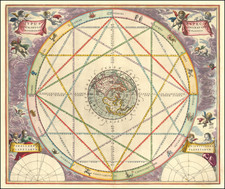
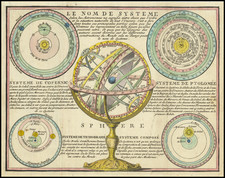
![[Lupus and Centaurus] (Stars Heightened in Gold)](https://storage.googleapis.com/raremaps/img/small/83191.jpg)
